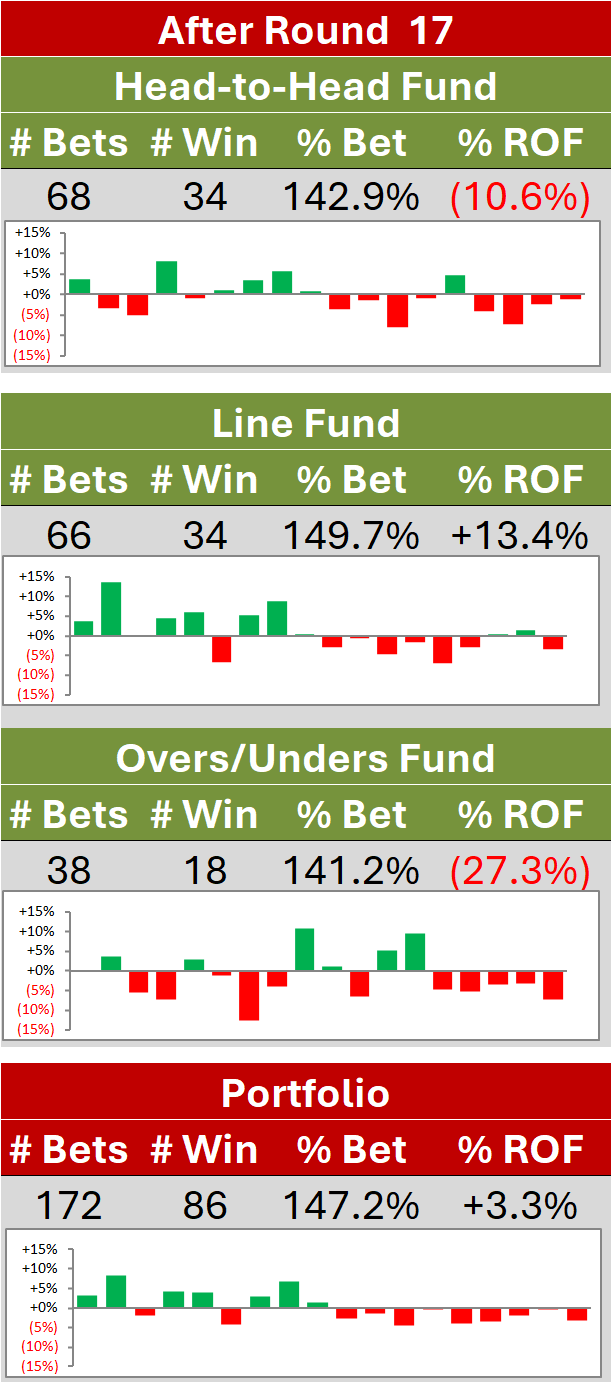To Bet or Not to Bet?
/In an earlier blog, using the 5 parameter model first discussed here, I summarised the results of simulating 100 seasons played out under each of 1,000 different parameter sets in a pair of rules that described when Kelly-staking tends to be superior to Level-staking, and vice versa.
Implicitly, that blog assumed that we were going to wager, so our concern was solely with selecting the better wagering approach to adopt. But there is, of course, a third option that dare not speak its name and that is not to bet at all. In this blog I'll extend the previous analysis and derive rules for when we should Kelly-Stake, when we should Level-Stake and when we should just upstakes and leave.
I've used the same dataset (the simulated results for the 1,000 parameter combinations) and the same approach (rule induction) as in the earlier blog. All I've added is a variable that takes on one of three values for a given parameter set:
- Kelly-Stake if the average simulated return to Kelly-Staking for that parameter set is positive and greater than the average simulated return to Level-Staking
- Level-Stake if the average simulated return to Level-Staking is positive and greater than the average simulated return to Kelly-Staking
- Don't Bet if the average simulated returns to both Kelly-Staking and Level-Staking are zero or negative.
Across the 1,000 parameter sets tested, Kelly-Staking was the recommended action about 20% of the time, Level-Staking about 31% of the time, and Don't Bet the remaining 49% of the time. These percentages form the base rates that the generated rules must exceed if they are to be of any predictive value.
Four rules emerged:
- If Punter Variability <= 5.1% and Bookie Variability >= 2.0% then Kelly-Stake, otherwise
- If Bookie Bias <= -2.6% and Overround <= 1.045 and Punter Bias >= -2.0% then Kelly-Stake, otherwise
- If Bookie Bias >= +2.6% then Level-Stake, otherwise
- Don't Bet
Rule 1 was valid for 108 of the 1,000 parameter sets and Kelly-Staking was the right strategy for 81% of those 108 sets.
Rule 2 was valid for 78 of the 1,000 parameter sets and Kelly-Staking was the right strategy for 51% of those 78 sets.
Rule 3 was valid for 205 of the 1,000 parameter sets and Kelly-Staking was the right strategy for 72% of those 205 sets.
Rule 4 was valid for 609 of the 1,000 parameter sets and Kelly-Staking was the right strategy for 70% of those 609 sets.
We shouldn't place too much store in the proportion of parameters sets for which the various strategies applied since the parameter sets were generated at random with no reference to their likelihood of occurrence in the wild. Instead, we should take notice of the proportion of times that the rule is correct when it is applied relative to the base rate of the recommended strategies within the dataset. On that basis, all of the rules have what is called in the rule-induction trade, acceptably high lift.
So, what to make of these rules?
Well, for any staking strategy to work it needs that the Bookie have some imperfection - that is, some bias or some variability. In the case of Rule 1, that vulnerability comes in the form of excessive variability; for Rule 2, it's an excessive bias towards Away teams and too generous an overround; and for Rule 3 it's an excessive bias towards Home teams.
For Kelly-Staking to work for a Punter, she needs to be sure that the standard deviation of her probability assessments are reasonably small and that those of the Bookie she's up against are not too small, or, alternatively, that the Overround she's being offered is sufficiently generous, the Bookie Bias is strongly towards the Away team and her own bias is not too strongly in favour of the Away team too.
Barring either of those two situations, Level-Staking is advised if the Bookie Bias is too heavily towards the Home Team.
Absent all of those circumstances she's best off not wagering at all.
What we still need to address is how to measure Bookie Bias and Variability, and how to measure Punter Bias and Variability.

